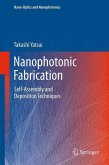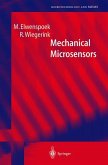This book introduces the use of industrial CMOS processes to produce arrays of nanomechanical cantilever transducers with on-chip driving and signal conditioning circuitry. These cantilevers are familiar from Scanning Probe Microscopy (SPM) and allow the sensitive detection of physical quantities such as forces and mass changes. The book is divided into three parts. First fabrication aspects and the mechanisms of cantilever resonators are introduced. Of the possible driving and sensing mechanisms, electrothermal and magnetic excitation, as well as piezoresistive detection and the use of MOS transistors for the deflection detection are introduced. This is followed by two application examples: The use of resonant cantilevers for the mass-sensitive detection of volatile organic compounds, and force sensor arrays for parallel Scanning Atomic Force Microscopy (AFM) of large areas.
This book is intended for scientists and engineers in the field of micro- and nano electro-mechanical systems (MEMS and NEMS) and introduces the development of cantilever-based sensor systems using CMOS-compatible micromachining from the design concepts and simulations to the prototype. It is also a useful resource for researchers on cantilever sensors and resonant sensors in general The reader will become familiar with the potential of the combination of two technological approaches: IC fabrication technology, notably CMOS technology, and silicon micromachining and the resulting microstructures such as cantilever beams. It was recognized early that these two technologies should be merged in order to make the microstructures smart and devise integrated microsystems with on-chip driving and signal conditioning circuitry - now known as CMOS MEMS or, with the arrival of nanostructures, CMOS NEMS. One way to achieve the merger is the post-processing micro- or nano- machining of finished CMOS wafers, some of which is described in this book. The book introduces this approach based on work carried out at the Physical Electronics Laboratory of ETH Zurich on arrays of cantilever transducers with on-chip driving and signal conditioning circuitry. These cantilevers are familiar from Scanning Probe Microscopy (SPM) and allow the sensitive detection of phys ical quantities such as forces and mass changes. The book is divided into three parts. First, general aspects of cantilever resona tors are introduced, e. g. their resonant behavior and possible driving and sensing mechanisms.
Hinweis: Dieser Artikel kann nur an eine deutsche Lieferadresse ausgeliefert werden.
This book is intended for scientists and engineers in the field of micro- and nano electro-mechanical systems (MEMS and NEMS) and introduces the development of cantilever-based sensor systems using CMOS-compatible micromachining from the design concepts and simulations to the prototype. It is also a useful resource for researchers on cantilever sensors and resonant sensors in general The reader will become familiar with the potential of the combination of two technological approaches: IC fabrication technology, notably CMOS technology, and silicon micromachining and the resulting microstructures such as cantilever beams. It was recognized early that these two technologies should be merged in order to make the microstructures smart and devise integrated microsystems with on-chip driving and signal conditioning circuitry - now known as CMOS MEMS or, with the arrival of nanostructures, CMOS NEMS. One way to achieve the merger is the post-processing micro- or nano- machining of finished CMOS wafers, some of which is described in this book. The book introduces this approach based on work carried out at the Physical Electronics Laboratory of ETH Zurich on arrays of cantilever transducers with on-chip driving and signal conditioning circuitry. These cantilevers are familiar from Scanning Probe Microscopy (SPM) and allow the sensitive detection of phys ical quantities such as forces and mass changes. The book is divided into three parts. First, general aspects of cantilever resona tors are introduced, e. g. their resonant behavior and possible driving and sensing mechanisms.
Hinweis: Dieser Artikel kann nur an eine deutsche Lieferadresse ausgeliefert werden.








